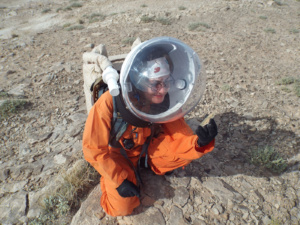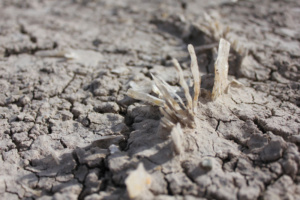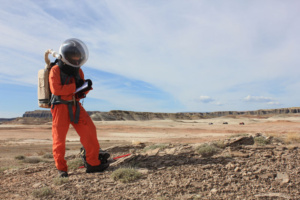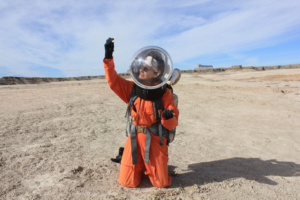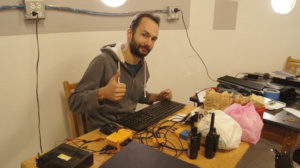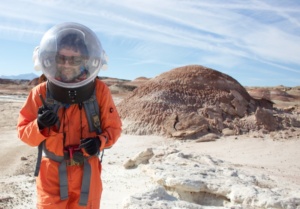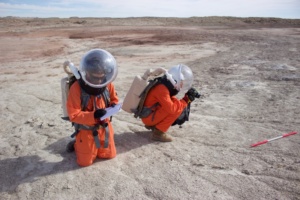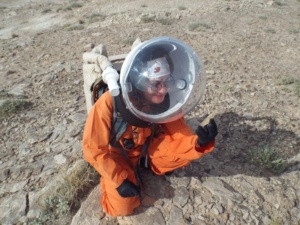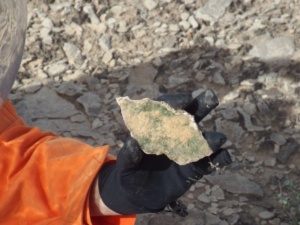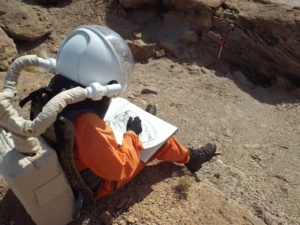Field Drawing Notes / Test One
Post by: Annalea Beattie
I began a field sketch of not too complex an outcrop of cross-bedded sandstone with the conglomerate top at the dry creek on the way home. It’s an old river channel that has eroded away with different sets of sand waves deposited one on top of the other.
We were on our way back to the hab towards the end of our EVA, close to midday and it was pretty warm.
This drawing is a test within a half hour time constraint- my first experiment with field drawing in the new spacesuit with the Lexan visor. (Lexan is what bullet proof glass is made out of, cockpit canopies and astronaut visors.)
I chose long charcoal sticks even though I never sketch in the field with these as I didn’t want to use a knife to sharpen pencils with bulky space gloves. Meanwhile, its apparent the sketchbook itself is too big – hard to handle in the space suit. I drew from the edges of the outcrop. Each part is related to the other in some way and I needed to constrain the outcrop boundaries to determine attitude (the angles at which the outcrops occurred), structural relationships and thickness in the cross bed sets in terms of layering, unloading, rock distribution, erosion and so on. On the top of the sandstone I sketched in the conglomeratic unit. Maybe it was caused by debris flow but I am guessing.
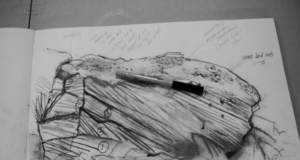
I drew in vegetation to give scale, and shadows to give three- dimensionality. I tried to see simple lines, divide the outcrop into differently orientated planes as well as indicate the texture. You know I don’t think much about what the drawing looks like. You can tell its a pretty bad drawing but as long as I can catch something that indicates how the outcrop was formed, for instance the processes of deposition or the direction of the currents which deposited the sediments, I’m happy.
Drawing is a practice, I can only improve and field drawing is about some kind of narrative, like field geology is an historical narrative science.
Half an hour later I am still drawing into the sun, there is a lot of glare. Sweat from my forehead kept trickling down in to my eyes and I really had had enough. Little flies were walking around on the face of my visor while I was drawing. After driving five kilometres on the quad bike and three hours in the spacesuit I realised field sketching should be an activity that should be done early in the EVA not towards the end.
Surprisingly though, the charcoal was reasonably successful as a drawing tool, perhaps because it’s versatile in terms of drawing texture and it suffers mistakes well. The upside is that no rubber was needed, I just smudged mistakes away with my glove.
The down-side is that charcoal needs fixing. Should have brought the hairspray but would this work on Mars ? Probably not.
Overall, as a process sketch in the field, test one was successful.
I understand quite a lot now about the outcrop as every mark on the page is something I have seen. I realise more about the physical limitations of drawing in the space suit and I understand timing is important in terms of when the field drawing is scheduled. And I have begun to think clearly about tools and techniques. Next, I will take the drawing to geologist Jon Clarke who helps me recognise what I have drawn. Then if it is useful for the science, I’ll use my field sketch and the documentation of the outcrop to create a figure drawing that focuses on sedimentary processes.




